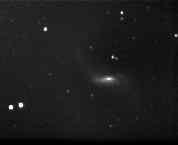 NGC2685, Polar ring galaxy in UMa,
05/18/99, jpeg, 8k
NGC2685, Polar ring galaxy in UMa,
05/18/99, jpeg, 8k
 NGC2685, Polar ring galaxy in UMa,
05/18/99, jpeg, 8k
NGC2685, Polar ring galaxy in UMa,
05/18/99, jpeg, 8k
I am pleased to notice, that my image shows the ring more clearly than the Palomar DSS image of NGC 2685. Enlarged for more detail.
NGC 660, shown below, contradicts this model of polar ring galaxies, but it must be emphasized that the ring in this case contains much more mass and it's diameter is much larger than in the 'normal' case.
Adjust your monitor to see the faint outer features.
 NGC660
,Large distorted galaxy in Pisces, 12/17/98, jpeg, 10k
NGC660
,Large distorted galaxy in Pisces, 12/17/98, jpeg, 10k
In a preprint from W. van Driel et.al., Nobeyama Radio
Observatory, Japan (NRO), 1994, I found the following
interesting details : "NGC 660 is a unique, nearby
object among the rare class of polar ring galaxies, since it
has a polar ring with an unusual morphology and a
gas-rich inner disk with a nuclear LINER spectrum, while other
objects of this class usually have a quiescent lenticular-type
disk. It has two distinct morphological and kinematic
components: a disk, viewed almost edge-on (i~70°), with a
major axis position angle of 45° and a diameter of
~11kpc [D=13 Mpc, H0=75km s-1 Mpc-1],and an outer ring (p.a.
170°) with a diameter of 31kpc, inclined on average 55° with
respect to the disk major axis. Though not truly 'polar' (i.e.
perpendicular to the disk), it can still be regarded as such
for all practical purposes, and we will therefore refer to it
as a polar ring. The ring appears to be rather inclined and
warped ..."
More images of galaxies can be found on my pages about
